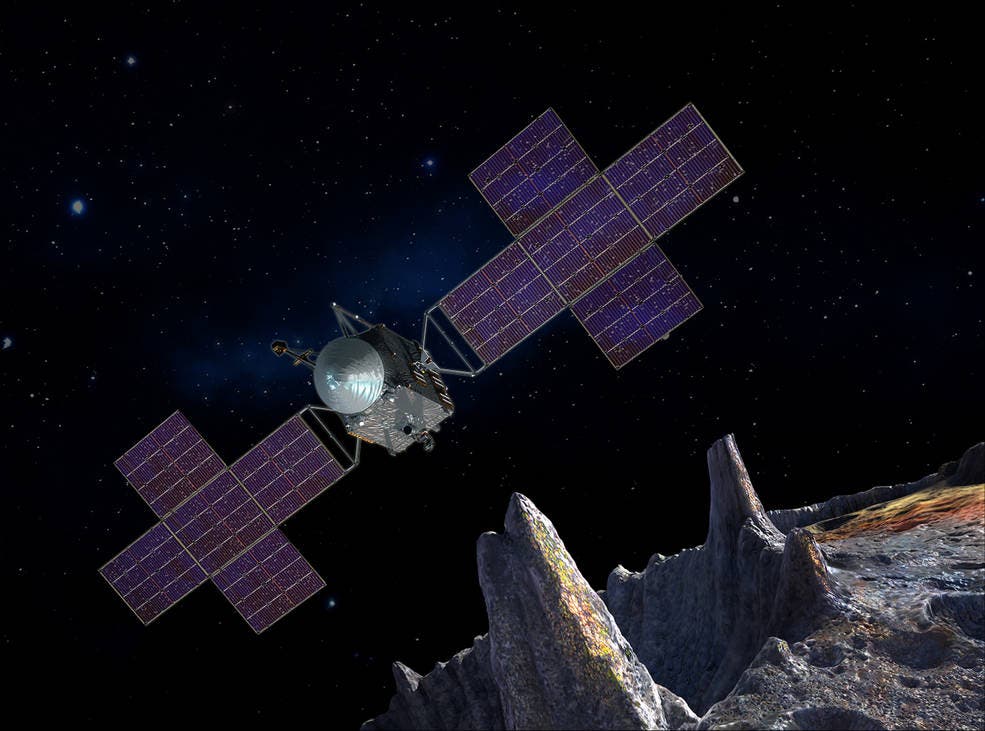NASA has accelerated their mission to explore a metal asteroid worth a gargantuan amount of money by four years.

Artist’s Concept of Psyche Spacecraft with Five-Panel Array. Image credits: NASA/JPL-Caltech/Arizona State Univ./Space Systems Loral/Peter Rubin.
The idea of mining asteroids is a relatively new one — let’s face it, a few decades ago it would have probably seemed preposterous — but it’s picking up steam fast. After all, Earth’s mineral resources, while incredibly vast, are not infinite. We’ve only recently starting to truly recycle and reuse those resources, but even so, with growing industrialization and rapid technological development, the belt is getting tighter and tighter. So naturally, scientists (and more recently, businessmen and governments) have started looking elsewhere for resources: up.
Psyche, NASA’s Discovery Mission to a unique metal asteroid (itself called Psyche) was set to reach its target in 2030. However, the timeline has been shifted significantly. The launch will now take place in 2022, and if everything goes alright, Psyche will reach its asteroid in 2026, four years earlier than initially anticipated. Astronomers didn’t do this just because they were eager, but rather because they found a better trajectory for this timing.
“The biggest advantage is the excellent trajectory, which gets us there about twice as fast and is more cost effective,” said Principal Investigator Lindy Elkins-Tanton of Arizona State University in Tempe. “We are all extremely excited that NASA was able to accommodate this earlier launch date. The world will see this amazing metal world so much sooner.”
Whenever such missions are launched, taking into account the influence of Earth’s gravity, as well as that of the other planets in our solar system, is crucial. This new trajectory means that Psyche won’t need an Earth gravity assist (basically, a sling around the Earth), which is more efficient and significantly shortens the cruise time. It also means the shuttle won’t travel so close to the Sun, which reduces the amount of protection it requires.
“The change in plans is a great boost for the team and the mission,” said Psyche Project Manager Henry Stone at NASA’s Jet Propulsion Laboratory, Pasadena, California. “Our mission design team did a fantastic job coming up with this ideal launch opportunity.”
Of course, NASA isn’t only interested in the economic prospect of the mission. Rather, their main interest is scientific. They believe that Psyche, one of the most massive asteroids in the asteroid belt, might be the exposed iron core of a protoplanet. This is exactly why the asteroid is so valuable and why there are already plans to explore it industrially. Radar observations of the asteroid from Earth indicate an iron–nickel composition, which suggests the possible existence of other metals, including some potentially valuable ones.
Still, while space mining remains a topic on which can set our imaginations ablaze, the potential scientific value of Psyche is also massive. If it is indeed an exposed planetary core, it can help us study a whole new kind of world. At the same time, it can enable us to better understand our own planet’s core, as well as the core of other planets — who knows, it may be very similar to Earth’s core, or maybe very different. Either way, it’s a trove of data just waiting to be discovered.
“Deep within rocky, terrestrial planets – including Earth – scientists infer the presence of metallic cores, but these lie unreachably far below the planets’ rocky mantles and crusts,” the project’s overview reads. “Because we cannot see or measure Earth’s core directly, Psyche offers a unique window into the violent history of collisions and accretion that created terrestrial planets.”
The mission’s payload will include magnetometers, multispectral imagers, and a gamma ray and neutron spectrometer.
The Psyche Mission was selected for flight earlier this year under NASA’s Discovery Program, a series of lower-cost, highly focused robotic space missions that are exploring the solar system.









